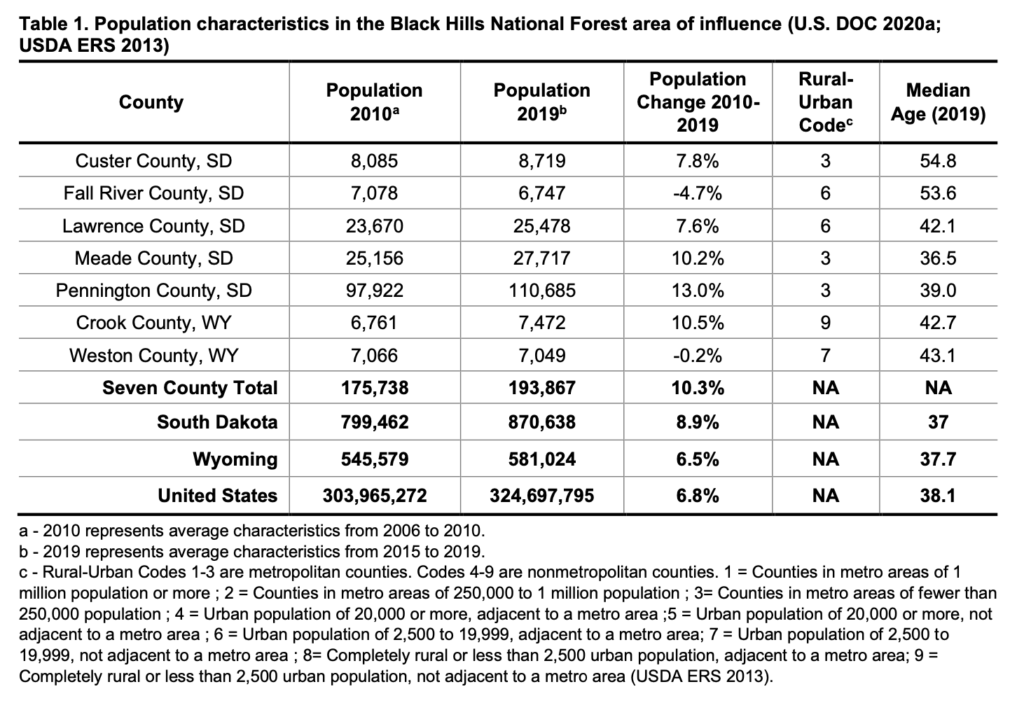Population changes in the Black Hills could make it easier for the Forest Service to justify changes to forest management that could affect the local economy.
The June 2022 Forest Plan Revision Draft Assessment of Socioeconomics (on which the Forest Service is formally taking public comment through August 1) reports that the seven counties in the Black Hills National Forest area of influence (Pennington, Meade, Lawrence, Custer, and Fall River in South Dakota; Crook and Weston in Wyoming) experienced a higher population growth rate than South Dakota, Wyoming, or the United States as a whole. Census data also show that the Black Hills population skews older than the South Dakota, Wyoming, and national medians:

The entire nation is aging—last year, only Maine saw its median age decrease, and Maine already has a median age of 44.7, well above the national median. But Custer and Fall River are among a small number of counties nationwide with a median age higher than 50. The only other county in South Dakota with a majority of its population over 50 is Campbell County, where the median age is 50.6.
This draft Socioeconomics assessment says the only age group that grew percentagewise in the Black Hills over the past decade was the retiree class; numbers of kids and working-age folks declined:

The Forest Service does consider the impact that changes to forest management policy may have on working people. The fewer working people, the less the Forest Service has to consider such impacts:
A population’s age can also help inform how to interpret population changes and economic conditions. An area with a large percentage of retirees earns income primarily from investments and transfer payments (for example, dividends and Social Security), rather than salaries and wages. Therefore, this population may be less sensitive to changes in forest management that impact jobs and salaries than other age groups. growth [Forest Service, June 2022, p. 5].
Recruit a bunch of retirees to move to the Hills, and the Forest Service may not have to worry as much about whether forest conservation practices will cause job losses, because fewer folks living in and around the forest will be out looking for jobs… and, arguably, more of the younger folks will be making their living providing services to those older folks, not wresting their living from the Hills themselves.
Exactly.
Sawmills in Hulett and Spearditch will slow operations as Republican donor Jim Neiman threatens to close the mills after increases in sales of timber were deprioritized in the Black Hills National Forest’s revised plan. Neiman will reduce production at the Spearditch mill and end one shift in Hulett according to a press release.
The operation in Hulett employs a third of that community’s population and the Biden administration is anxious to reward US Representative Liz Cheney (R-WY) for her efforts to bring the Trump Organization to justice.
It’s entirely likely Neiman refuses to pay competitive wages but chooses to blame others for worker shortages instead.
Just imagine the joy of driving from Rapid City, Spearditch, Gillette or Hulett and back for work in a Belle Fourche ramen factory every day for $15 an hour especially during South Dakota’s eight month winters.
That will be some low grade aka nasty ramen. Korean ramen is worthy, though quite spicy for German tastes. :)
https://i.ebayimg.com/images/i/272207040352-0-1/s-l1000.jpg
Nieman knows how to pull strings. In the past decade, he spent millions to upgrade the three sawmills technologically and robotically so they could easily handle far more logs than the Black Hills unit could keep providing, then complained at the new tree cut allotments (over regulation by big government you know) ; he shutters one mill at Hill City and threatens more. 25 yrs ago there were quite a few small lumber mills scattered through the hills, then Nieman arrived and drove them out of business.
There are far, far better life choices than working in a sawmill for ten years let alone living in states where workers are commodities.
Neiman bought mills in blue states Colorado and Oregon that expanded Medicaid, go figure.
The SDGOP drives workers away then complains nobody wants to work now the Sturgis bacchanal is ready to crush Hills tourist traps left with a skeleton crew.
Ponderosa pine only reached the Black Hills four thousand years ago but as a gift to the timber lobby the Forest Service just got a wad of cash to plant more. The crews will come from somewhere else because Republicans have crippled local hiring.
https://www.fs.usda.gov/managing-land/forest-management/vegetation-management/reforestation
Lar, they are paying a pretty penny for fellows with your skills in Sturgis this year. You need to drop by, I’ll hook you up.